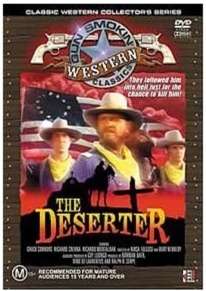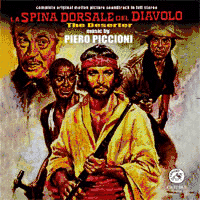The Deserter (1971 film)
The Deserter (Italian: La Spina Dorsale Del Diavolo) is a 1970 Italian-American Western film by Dino De Laurentiis. It was directed by Burt Kennedy.
| |
|---|---|
 | |
| Directed by | Burt Kennedy |
| Produced by |
|
| Written by |
|
| Starring | |
| Music by | Piero Piccioni |
| Cinematography | Aldo Tonti |
| Edited by | Frank Santillo |
Production company | |
| Distributed by | Paramount |
Release date |
|
Running time | 100 minutes |
| Country |
|
| Language | English |
Scripted in the style of The Dirty Dozen (1967), and designed as a vehicle for Yugoslavian theater and film matinee idol Bekim Fehmiu, the film featured an ensemble cast of well-known American actors.[1] Noted as the boy in Shane (1953), actor Brandon deWilde appears in his last Western film before his death in 1972.[2][3]
The film was shot largely on location in Italy, Spain and Yugoslavia. Many exterior scenes were filmed at the Fort Bowie set built in the Province of Almería, Spain, where the desert landscape and climate that characterizes part of the province have made it a much utilized setting for Western films, among those A Fistful of Dollars (1964), The Good, the Bad and the Ugly (1966) and later 800 Bullets (2002). This same set was also used in the films Blindman (1971) with Ringo Starr and A Reason to Live, a Reason to Die (1972).[4]
Plot
A US Army cavalry unit returns from a 2-week patrol to find the inhabitants of an outpost near its home fort have been killed by Apache Indians. Among the victims is the savagely tortured wife of the patrol's leader, Capt. Victor Kaleb (Bekim Fehmiu).
Kaleb believes part of the fault lies with the passive fort commander, Major Wade Brown (Richard Crenna). Kaleb shoots and wounds Brown, and deserts the army. He disappears into the southwestern frontier to wage a private war of revenge against Apaches.
Two years later General Miles (John Huston) arrives at the fort with an offer for Kaleb. The scouts Natchai (Ricardo Montalbán) and Tattinger (Slim Pickens), old friends of Kaleb, are sent out to entice him (and his pet wolf-dog) back to the fort. With a bit of trickery they succeed.
General Miles tells Kaleb Apaches led by Chief Mangus Durango have gathered in Mexico, intending to cross the border and attack at any time. The General, over Brown’s objections, promises Kaleb amnesty in exchange for leading a select band of soldiers across the border to wipe out the Apache stronghold known as "La Spina Dorsale Del Diavolo", the Devil's Backbone.
Kaleb has his pick of the men at the fort. They include dynamite expert Reynolds (Chuck Connors), who also is a priest; knife-fighting expert Jackson (Woody Strode); Gatling gun expert Robinson (Patrick Wayne) and grizzled veteran Schmidt (Albert Salmi). Most of the men hate Kaleb. A blustery Englishman, Crawford (Ian Bannen), sent by the British Army to study frontier tactics, and young army Lt. Ferguson (Brandon deWilde), volunteer to go along.
Kaleb leads them into the desert to train them for the mission. It is severe, and results in some deaths. The band also encounters Apaches, who they kill. On their return to the fort, Major Brown reveals that, despite the general’s amnesty offer, he intends to arrest Kaleb for having shot him two years ago. In response the general orders Brown to accompany Kaleb on the mission. Brown cannot disobey. Natchai and Tattinger go along as well.
They cross the border. After smaller skirmishes there is a fierce battle with the main body of the Apache troops. Kaleb's elite force wins, in large part due to the advantages proffered by dynamite and machine gun fire. The victorious survivors return to the fort, where an embarrassed General Miles explains that despite his amnesty offer he has been ordered to arrest Kaleb. Colonel Brown suggests the resolution: they will all say Kaleb was killed in action at the Devil's Backbone. Kaleb mounts up and rides away from the fort back into the desert.
Cast
- Bekim Fehmiu as Captain Victor Kaleb
- John Huston as General Miles
- Richard Crenna as Colonel Wade Brown
- Chuck Connors as Chaplain Reynolds
- Ricardo Montalbán as Natachai
- Ian Bannen as Captain Crawford
- Brandon deWilde as Lieutenant Ferguson
- Slim Pickens as Tattinger
- Woody Strode as Jackson
- Albert Salmi as Schmidt
- Patrick Wayne (as Pat Wayne) as Captain Bill Robinson
- Fausto Tozzi as Orozco
- Mimmo Palmara as Chief Mangus Durango
- John Alderson as O'Toole
Reception
In his investigation of narrative structures in Spaghetti Western films, Fridlund writes that The Deserter mainly follows the "Professional Plot", as described by Will Wright in his analysis of American Westerns, that is the cooperation of a group of professionals fulfilling a mission.[5][6]
Home media

Video
The Deserter was originally released on VHS in the United States by Paramount Home Entertainment, on September 9, 1992. Paramount has not released the film as a DVD in North American Region 1. It is presently available in DVD Region 0 by East West Entertainment LLC in standard non-widescreen VHS conversion and Region 4 by Reel Corporation, Australia.
Soundtrack
The score for The Deserter had music composed and conducted by Piero Piccioni. Originally a practicing lawyer securing movie rights for Italian film distributors, he was eventually credited with scoring over 300 films. Piccioni was influenced in his use of jazz by 20th century classical composers and American cinematography and this is apparent in The Deserter soundtrack.[2]
Piccioni's score was released on CD in Italy in 1997 on the Legend label, as CD 28, 14-tracks under the title Piero Piccioni: La Spina Dorsale Del Diavolo. Recent discovery of the stereo master tapes of the original session, with an extra 25 minutes of music, is featured on the limited 1500 unit special edition Legend CD 32 DLX, released July, 2010, as a 26-track 74:34 CD.[2]
See also
References
- The Deserter on IMDb
- RememberingBrandon.net
- Wildest Westerns Magazine
- Western Locations Spain
- Wright, Will: Sixguns & Society. A Structural Study of the Western. University of California Press, 1975.
- Fridlund, Bert: The Spaghetti Western. A Thematic Analysis. Jefferson, NC and London: McFarland & Company Inc., 2006 pp. 209–210.